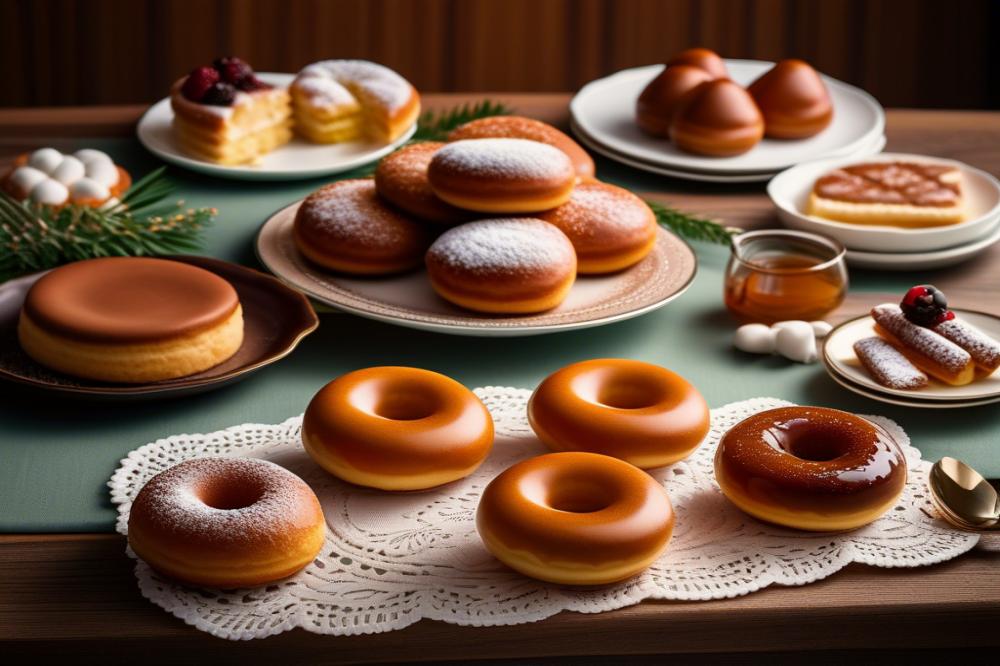Making Sweet Polish Desserts: Faworki and Pączki
Poland’s culinary landscape is rich and diverse, especially when it comes to desserts. Traditional sweet pastries have a special place in the hearts of many families. Each recipe tells a story and connects generations. Polish cuisine honors its roots through these delightful creations, often enjoyed during festive occasions. Many desserts serve not just as treats but also as reflections of the culture’s values and traditions.
Among the numerous offerings, Faworki and Pączki stand out. Faworki, known for their crispy, flaky texture, are a favorite during celebrations like Fat Thursday. These sweet, ribbon-like desserts are dusted with powdered sugar, perfect for sharing and enjoying with friends. Pączki, on the other hand, are rich doughnuts filled with various delicious fillings, like jam or cream. They symbolize indulgence and have become synonymous with Polish festivities.
Exploring these cultural sweets is not merely about taste; it’s about experiencing heritage. Each bite of a Pączek can transport you to a Polish bakery bustling with activity. Learning traditional recipes can deepen your appreciation for the craftsmanship behind these desserts. Adventurous food lovers are invited to join culinary experience holidays in Poland. Embark on a journey that delights the senses and celebrates sweet pastry making, creating lasting memories with every delectable bite.
Understanding Polish Desserts
Poland has a rich tradition of desserts. These cultural sweets defined by their delightful flavors and textures offer a glimpse into the heart of Polish cuisine. Sweet pastries hold a special place in the lives of many. They are often enjoyed during gatherings and celebrations, bringing people together and creating lasting memories.
Festive treats play an important role during holidays. People cherish traditions that involve dessert making, especially around significant events like Fat Thursday. That day, many indulge in Pączki, deep-fried dough filled with fruit preserves, custard, or other delicious surprises. These round delights are coated in powdered sugar, making them irresistible.
Flaky dessert options like Faworki also have a cherished spot among Polish delights. With their delicate, crispy texture, these twisted pastries are often enjoyed with tea or coffee. traditional recipes for Faworki may vary slightly, but the love for them remains constant.
Understanding the significance of sweet pastries in Poland goes beyond taste. Each recipe carries a story, connecting generations through shared experiences. The art of preparing these desserts creates community and spirit, making every occasion special. Celebrations feel incomplete without these treats, as they add sweetness to every moment.
Faworki: The Flaky Delight
Faworki, also known as Angel Wings, are delightful sweet pastries celebrated in Polish cuisine. These delicate treats are characterized by their crispy, flaky texture. When you take a bite, the dough shatters beautifully, making each mouthful a joy. Unlike many desserts, faworki are not overly sweet. They carry just a hint of sweetness, enhanced by a dusting of powdered sugar. This balance makes them a perfect addition to any festive celebration.
Traditional Recipes for Making Faworki
Making faworki at home can be a rewarding experience. A traditional recipe typically calls for flour, eggs, a dash of sour cream, and a splash of vodka or rum. The alcohol helps create that light and airy texture. First, mix the ingredients to form a smooth dough. Afterward, let it rest to develop its elasticity. Once rested, roll out the dough thinly and cut it into strips. Twisting each strip into a bow shape is crucial to the final look of these pastries. Deep-frying them until golden brown yields the perfect crunchy exterior.
Tips for Achieving the Perfect Flaky Dessert
Patience is key when preparing faworki. To achieve the ideal flaky texture, roll the dough as thin as possible. If it’s too thick, the final product may be dense instead of light. Ensure the oil is hot enough before frying. A good test is to drop in a small piece of dough; if it sizzles immediately, you’re ready to go. Drain them well after frying to avoid the greasy aftertaste. Lastly, don’t forget that festive dusting of powdered sugar. It enhances the appearance and adds a final touch of sweetness.
Regional Variations and Their Significance
Different regions of Poland boast their own takes on faworki, which adds to their charm. In some areas, you might find variations that include flavors like vanilla or lemon zest. Others may prefer a touch of cinnamon in the dough for an added warmth. These differences reflect local tastes and traditions, showcasing the versatility of this beloved dessert. Faworki are especially popular during the carnival season, symbolizing celebration and indulgence before Lent begins. Enjoying them during special occasions makes these cultural sweets even more meaningful.
Pączki: The Iconic Polish Treat
Pączki are beloved sweet pastries that hold a special place in Polish cuisine. These delightful doughnuts are filled with various flavors and dusted with powdered sugar. More than just a dessert, they are a symbol of celebration and tradition, especially during special occasions.
Traditional Recipes for Pączki
Making pączki involves a few key steps. Begin by preparing a rich dough using flour, yeast, milk, eggs, and butter. Knead the mixture thoroughly to achieve that soft, pliable texture. Letting the dough rise is crucial; it ensures a light and fluffy treat. After it has risen, roll it out and cut into circles. Don’t forget the filling! Place a spoonful in the center, fold it over, and seal the edges tightly. Fry them in hot oil until golden brown. It’s important to cool the pastries on paper towels before adding toppings.
Common Fillings and Toppings
Pączki showcase a variety of fillings that add to their charm. Some popular options include fruit jams, creamy custards, and even chocolate. Raspberry and rose jam remain classic favorites. Once cooked, the pączki are often finished with a generous dusting of powdered sugar or a sweet glaze. These toppings not only enhance the appearance but also elevate the flavor.
Cultural Significance of Pączki
The cultural importance of pączki is most evident during Fat Thursday, known as Tłusty Czwartek in Poland. This day marks the last Thursday before Lent begins, and it is a time to indulge before the fasting period. People flock to bakeries to buy these festive treats, celebrating community and heritage. For many, enjoying pączki is a cherished family tradition, connecting generations through dessert making.
The Art of Dessert Making
To create delightful Faworki and Pączki, knowing essential ingredients is vital. Basic components include flour, eggs, sugar, and butter. These items form the foundation for the dough. Don’t forget a pinch of salt to enhance the flavors. For Pączki, adding yeast contributes a soft and fluffy texture. Understanding the role of each ingredient helps in producing authentic sweet pastries.
Dough Preparation
When making dough, proper technique is crucial. Begin by mixing the dry ingredients in a bowl. Slowly incorporate eggs and melted butter. This step is where the magic happens, transforming dry elements into a cohesive mixture. Knead the dough until it’s smooth and elastic. Don’t rush this part; a well-kneaded dough will yield better baked goods.
Step-by-Step Guide for Beginner Bakers
Ready to dive in? Follow this simple guide to embark on your dessert making adventure. For Faworki, roll the dough thinly and cut it into strips. Twist each strip into a shape before frying. Heating oil is key for achieving that crispy finish. If working on Pączki, shape smaller balls and let them rise. Fry these treats until golden brown, then coat them in powdered sugar.
Beginner bakers should remain patient. Baking benefits from practice. Mistakes may happen, but they often lead to learning. Don’t hesitate to experiment with flavors. Adding fruit fillings or different spices can create unique variations of these cultural sweets.
Tips for Mastering Polish Dessert Techniques
Mastering these desserts requires attention to detail. Pay close attention to frying temperatures. Too hot? The outside cooks too quickly, leaving the inside raw. Too low, and the pastries absorb too much oil, becoming greasy. Using a thermometer can help achieve the right heat.
Remember, timing plays a major role in baking. Allowing dough to rest improves the final product. It provides a chance for flavors to develop while enhancing textures. Enjoy the process as you create these festive treats. Share your results with family and friends. They will appreciate your efforts in making such delightful Polish cuisine.
Exploring Culinary Holidays in Poland
Why not embark on a culinary adventure holiday focused on sweet Polish desserts? This experience opens up a world of flavors and techniques that celebrate rich traditions. Enthusiasts of cooking and baking will find joy in learning about Pączki, the delightful jelly-filled doughnuts loved across Poland.
Traveling through this vibrant country provides countless opportunities to learn traditional recipes from local chefs. Expert cooks share their knowledge in friendly and inviting workshops. You’ll discover secrets behind creating flaky desserts like faworki, which are the ultimate festive treats often enjoyed during special occasions.
Every corner of Poland offers a slice of its culinary heritage. Participants will not only make sweet pastries, but they will also engage with the culture surrounding food. Local chefs often weave stories about their family recipes while demonstrating how to make these cultural sweets. This connection adds depth to the cooking experience.
During dessert-making workshops, visitors can immerse themselves in the joy of mixing dough and shaping treats. Learning to coat Pączki in powdered sugar or fill them with delectable fillings creates a bond with Polish cuisine. Each bite of these delicious desserts reveals a story from the past, fostering appreciation for the artistry involved.
Moreover, tasting each creation serves as a reward that ties it all together. Sharing the fruits of labor with others enhances the joy of cooking. Setting the table with beautiful, homemade sweets unites people and creates lasting memories. Participating in these workshops is more than just about food; it’s about understanding a way of life that celebrates joy through flavors.
Final Thoughts on Sweet Treasures
Faworki and Pączki hold a special place in the heart of Polish culture. These delightful treats are more than just desserts; they represent centuries of tradition and family gatherings. Each bite not only satisfies a sweet tooth but also connects us with generations past. It’s beautiful to think about how these snacks have woven themselves into celebrations and everyday life.
Thinking about exploring this rich tapestry of flavors? Culinary holidays in Poland offer a fantastic opportunity. Picture this: taking part in workshops where you learn to make these delicious pastries from local experts. You would get hands-on experience with traditional recipes that have been passed down within families. Imagine enjoying the fruits of your labor while surrounded by the vibrant culture of Poland!
Making and sharing these sweets can be incredibly rewarding. Baking with friends and family strengthens bonds. You make memories that can last a lifetime. The joy found in preparing Faworki and Pączki is only matched by the happiness they bring when shared with loved ones. So why not dive into this delightful world? Your taste buds will thank you, and your spirit will rejoice in every delicious bite.



